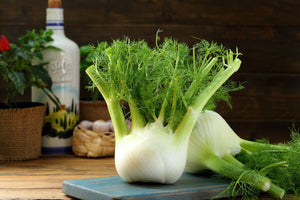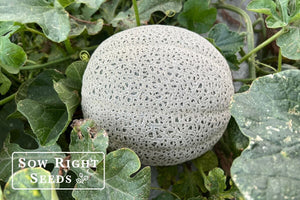Growing Gourds from Seed for Birdhouses, Decor, and More!
GourdsGourds are the perfect crop to grow just for the fun of it! Although gourds are edible when they are small, most gardeners enjoy growing them for the creative expression that gourds unleash. You can create all kinds of things with dried gourds. Gourds can be transformed into birdhouses, lanterns, bowls, spoons, and even musical instruments! Learn more about growing gourds and drying them for decorating and crafting.

How to Grow Gourds from Seed
Timing your seed starting will give you time to grow and dry your gourds for decoration and craft projects. Larger gourds can take 120 days to mature. You may benefit from starting your seeds indoors depending on your growing zone. A few extra weeks can mean the difference between a fully mature gourd that is beginning to dry and one that isn’t ready when the first fall frost comes.
Tips for fail-proof gourd seed germination
Gourd seeds have a tough outer shell, just like their mature produce. To encourage better germination, we have a few tips.
You can soak gourd seeds for 24 hours before planting.
Another tip for fail-proof seed germination is lightly scarifying your seeds by scratching them with sandpaper. Scarification helps to break down that hard outer coating.
Keep seeds moist until they germinate, which can take 7 to 14 days.
Sow seeds in warm soil, 70 to 80ºF.
To start gourd seeds indoors:
Place 2 to 3 gourd seeds per growing cell in seed starting mix.
Keep the soil moist until the seeds have germinated. This can take 7 to 14 days.
Once the seedlings are several inches tall and have at least 2 true leaves, you can start hardening them off.
Once they have acclimated to outdoor growing and all danger of frost is passed, they can be transplanted into the garden.
Transplant gourd seedlings outdoors when night temperatures are above 70ºF.
To direct-sow gourd seeds:
Once all danger of frost is passed, you can direct-sow gourd seeds in the garden.
Plant 3 to 4 gourd seeds per mound or hill.
Plant seeds 1” deep.
Keep seeds moist until they germinate in 7 to 14 days.

How to Grow Gourd Plants
Gourds need rich, fertile soil for healthy growth. A well-draining loam with a pH range of 6.5 to 7.5 is optimal.
Give gourds lots of room to spread. These vining plants will grab hold of whatever they can with their curling tendrils. Space gourd plants at least 24” apart. Larger varieties can even be 72” apart.
Trellising is an excellent way to save space and keep the gourds off the ground. You can create a shady walkway with an arch covered in gourd vines. Growing gourds on a trellis can also improve their shape.
Grow gourds in a sunny location. Gourds need full sun, meaning at least 6 hours of sunlight daily.
Gourds in the Lagenaria genus have white flowers that open in the evening and stay open during the night. They are then pollinated by moths.
Gourd plants will produce both female and male flowers. To ensure pollination of the female flowers, some gardeners will hand pollinate. Either with a small brush or by taking the male flower to the female flower and transferring the pollen.
Solutions for gourd pests and diseases
Cucumber beetles and squash vine borers are two frustrating pests that attack gourds.
Use row covers on seedlings and put straw mulch around plants to keep the beetles from getting to the leaves and blossoms. Hand-picking them and knocking them into a bucket of soapy water will keep them from destroying your plants.
Watch for beetles and moths around the bases of the plants, and remove any eggs you find.
Harvesting gourds
Gourds are edible, while they’re still immature. But most gardeners grow them for decor and crafts. This means leaving the gourds on the vines to fully mature.
When the stem turns brown and dries out, it’s time to harvest your gourds. Since gourds aren’t grown for eating, it’s okay if they stay on the vine a little longer. Harvesting them too early will result in gourds that rot instead of dry out.
A gourd that has fully matured and started drying out will be lighter.
Use a sharp knife to cut them off. Cut off a long stem to use for your crafting or to hang for drying.

How to Dry Gourds for Crafts
Wash the gourds to remove dirt and debris.
Use disinfectant to wipe down the gourd. This will help kill organisms or bacteria that could make it rot instead of drying out.
Dry off each gourd.
To allow the gourds to cure and dry completely, put them in a warm, well-ventilated, and dry location.
Place gourds on shelves off the ground and separate so they aren’t touching.
In a few weeks, the outer skin will harden. It will take a few more weeks for the inside to dry completely.
When a gourd is completely dry, the seeds should rattle inside.
Depending on the size of the gourd, this can take a month to six months.
Once gourds are dry, they can be painted or waxed. Depending on the look you are going for, you can also scratch designs into the surface or smooth it with sandpaper.
Heirloom Decorative Gourds to Grow
Bottle Gourd
The Bottle Gourd is popular to grow and use in crafts because of its unique shape. It is sometimes called a birdhouse gourd.
Bottle Gourds are excellent for making birdhouses for purple martins. These birds will thank you by eating insects in your garden.
Luffa Gourd
Luffa gourd is different because it’s the inside that is used for crafts and other purposes. You can learn more about growing and drying luffa gourds.
Dipper Gourd
Dipper gourds are excellent for fall crafts. It has a beautiful natural tan color and smooth skin. It can be kept natural and waxed or shellacked. Or it can be painted.
Small Decorative Gourds
These striped and warty gourds are fun to use in fall decor. Their small size means they will dry quickly. Keep the stems long to hang and dry.
Grow your own heirloom gourds!
Crafting with nature is fun and easy. Let your imagination run wild with these decorative gourds. Their hard skins lend to making vases, birdhouses, art projects, and even useful objects such as spoons and bowls.
See where your creativity takes you with these heirloom gourd seeds from Sow Right Seeds.
Found this information helpful? Share it with your gardening friends!




Leave a comment